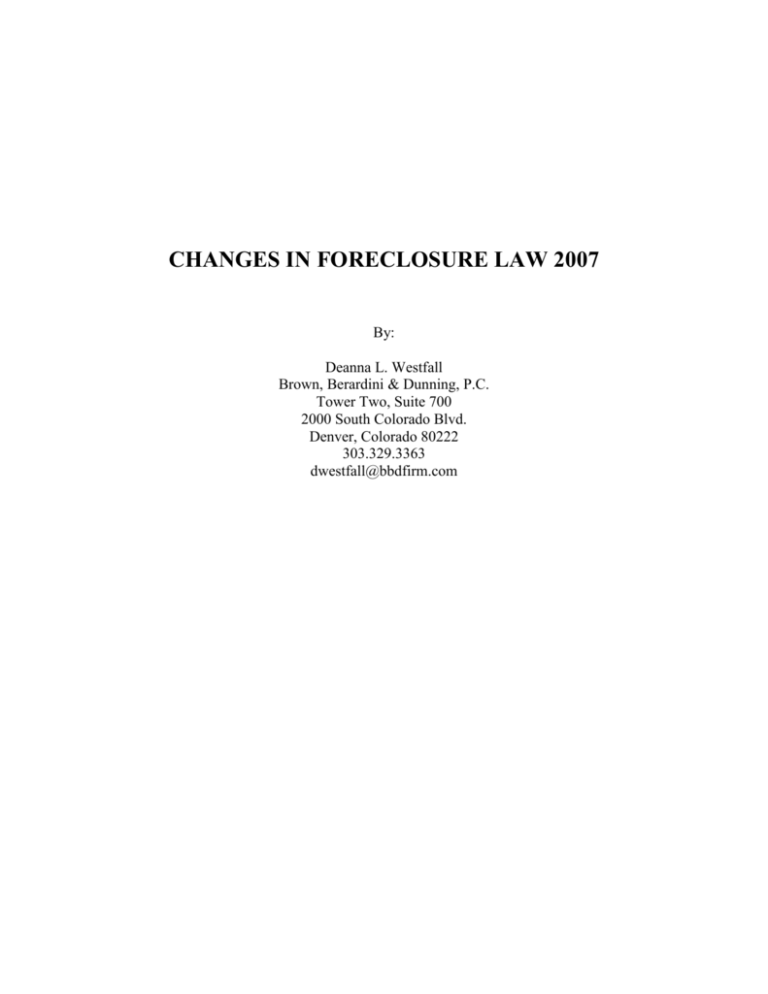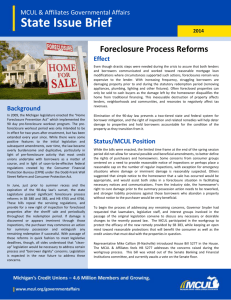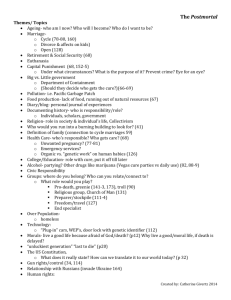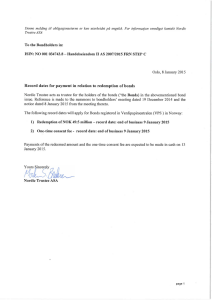CHANGES IN FORECLOSURE LAW 2007
advertisement

CHANGES IN FORECLOSURE LAW 2007 By: Deanna L. Westfall Brown, Berardini & Dunning, P.C. Tower Two, Suite 700 2000 South Colorado Blvd. Denver, Colorado 80222 303.329.3363 dwestfall@bbdfirm.com INTRODUCTION In July, 2007, a substantially re-written foreclosure statute will become effective. While portions of the statute were effective earlier, the majority of the changes take effect in July, 2007. In part, the changes lengthen the time between commencement of foreclosure and sale, eliminate the owner’s redemption period, and increase the number of weeks a sale can be continued from the original sale date. The goals of the new statute include increasing bidding at foreclosure sales, which generally speaking, benefits the borrower and the foreclosing lender. Under current law, bidding is almost non-existent. Before diving into the new law, for the sake of comparison, it is helpful to review the statute as it exists now. A. OVERVIEW OF CURRENT LAW The statutes that govern both Public Trustee foreclosures and judicial foreclosures in Colorado are provided in Title 38 of the Colorado Revised Statutes. Colo. Rev. Stat. § 38-38-101 et seq. A Public Trustee foreclosure is commenced by the filing of a Notice of Election and Demand (NED). A judicial foreclosure is commenced by the filing of a Complaint and Lis Pendens. From commencement to Public Trustee sale on non-agricultural real property takes approximately 45-60 days. Until the day prior to sale, the owner and certain others have the right to cure the default by paying the back payments plus other charges to the lender. Cures are tendered through the Public Trustee’s office. The Public Trustee obtains cure figures, provides 2 them to the debtor, accepts the cure funds, and then provides the funds to the foreclosing lender. If a cure is tendered, the foreclosure sale is canceled. Following the foreclosure sale, the owner has a 75 day redemption period, followed by successive redemption periods for each lienor junior to the foreclosing lender. A redemption is a complete payoff of all amounts owed to the foreclosing lender, including post-sale costs and interest. For example, if the first lien is foreclosing, the second lien may redeem up to day 85, the subsequent lienors each have successive 5 day redemption periods. If the owner redeems, all junior liens stay in place. If the owner does not redeem, any junior lienor that does not redeem loses its lien. Owners of agricultural land have a 6 month redemption period, followed by the same 10day and 5 day periods for junior lienors. Thus, a foreclosure under current law, without any delays, can be completed in approximately 135 days. At the completion of the foreclosure process, a deed issues in the name of the purchaser at sale or its assignee. This is usually the foreclosing lender. B. OVERVIEW OF NEW LAW Title 38 has been substantially rewritten. What follows is a few of the highlights. For anyone conducting foreclosures, I strongly recommend spending time reviewing all of the changes, including, but not limited to, those highlighted here. 3 I. REDEMPTION AND CURE The most striking change is the elimination of the owner’s redemption right. In its place, the statute provides a much longer period in which the owner, and many others, may cure.1 Specifically, a Public Trustee foreclosure sale on non-agricultural real property can be set within 110-125 days, and on agricultural real property, within 215-230 days. Thus, the extra days that previously encompassed the owner’s redemption period are now included in the time period prior to sale. Furthermore, the sale can be continued up to 9 months from the date of the NED, rather than the previous six month limitation. Each continuance provides another period of time for the owner or others to cure. Although the owner no longer has the right to redeem, junior lienors do. See Colo. Rev. Stat. § 38-38-302. Under the new law, all junior lienors must file an intent to redeem within 10 business days after the sale. Id. The first redeeming junior lienor must redeem within 15-20 days after sale. Id. Each subsequent junior lienor must redeem within 5 days after the prior redeeming lienor. Id. On day 11 post-sale, the Public Trustee will set the redemption deadlines, based on the intents received prior to that date. Id. II. FORECLOSING LENDER RESPONSIBILITIES The new law provides some specific requirements and penalties for foreclosing lenders. An intent to cure must be presented to the Public Trustee at least 15 days prior to sale. However, 1 In Section 38-38-104, the new law describes those who are entitled to cure. It is a broader definition than in the prior version of the Section. Although it is broader, it does limit the entities entitled to cure to those obtaining an interest in the property prior to the recording of the NED or Lis Pendens. This means more entities or persons are able to cure the loan with the foreclosing lender. It does not mean that the party affecting the cure is entitled to maintain the loan with the foreclosing lender as if it were an assumption. 4 if a cure amount is requested more than 30 days prior to sale, the lender must provide cure figures within 10 days of the request or face a fine of $150 or 1/32 of 1% of the debt, whichever is greater. Colo. Rev. Stat. § 38-38-109(c)(1)(B). If cure figures are requested within the 30 days prior to sale, the lender must provide them at least 7 days prior to sale or the sale will be continued from week to week. Id. If the continuance would place the sale outside the allowed 9 month sale period, the foreclosure sale will be deemed withdrawn. Id. Keeping with the idea of stricter requirements for foreclosing lenders, the new law also requires that bids for the foreclosure sale be submitted 2 days prior to sale instead of 1 day. The bids are also made public, which was not necessarily the case under the prior law. See Colo. Rev. Stat. § 38-38-109. III. COMMENCEMENT AND APPLICABILITY The new law applies to new foreclosures commenced after July 1, 2007. Thus, the NED or Lis Pendens must be recorded after July 1, 2007. There will be a period of approximately 6 months during which the Public Trustees will have to deal with pending foreclosures under both the new and the old laws. After that time, there will still be a few old law foreclosures pending based on continuances due to bankruptcy filings. 5 C. SUMMARY The new law makes many small changes and a few large ones. Until the new law has been in place for a year or more, we will not know if it has made the process more debtorfriendly or if it has increased the amount of bidding at foreclosure sales. 6







